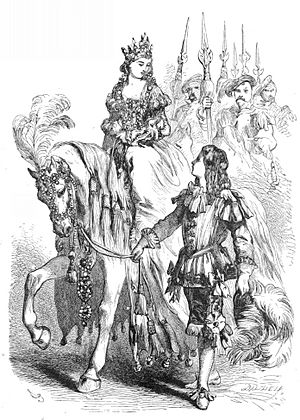Graciosa and Percinet facts for kids
Graciosa and Percinet is a classic French fairy tale. It was written by a famous author named Madame d'Aulnoy. This magical story was also included in The Red Fairy Book by Andrew Lang. It tells the adventures of Princess Graciosa and her brave helper, Percinet.
Contents
The Story of Graciosa and Percinet
A New Queen and a Wicked Plan
Once upon a time, there was a beautiful princess named Graciosa. Her parents, the King and Queen, loved her very much. Sadly, the Queen passed away. The King was very sad. His doctors told him to go hunting to feel better.
During his hunt, the King met a very rich Duchess. She was not kind and disliked Graciosa. The Duchess wanted to marry the King. But she had one condition: she wanted to be in charge of Princess Graciosa. The King agreed, and they got married.
Percinet's Magical Help
Graciosa's nurse helped her to be polite to the new Queen. Soon, a handsome young man named Percinet appeared. He was a rich prince with special fairy powers. Percinet was there to help Graciosa.
He gave Graciosa a beautiful horse to ride to greet the Duchess. The horse made the Duchess look very plain next to Graciosa. The Duchess demanded the horse for herself. She also wanted Percinet to lead it for her, just like he did for Graciosa.
However, the horse ran away with the Duchess. This made her look even worse. The Duchess was very angry. She ordered Graciosa to be beaten. But Percinet used his magic! The rods turned into soft peacock feathers, and Graciosa was not hurt at all.
The Queen's Cruel Tricks
The royal wedding went on. The King held a tournament to make the new Queen happy. The King's knights won against all challengers. But then, a young challenger appeared. He defeated everyone. He showed a picture of Graciosa, saying she was the most beautiful woman.
The Queen was furious. She had Graciosa taken far away and left in the woods. Percinet quickly rescued her. Graciosa wanted to go back to her father. Percinet showed her that the Queen had tricked the King. The Queen had said Graciosa was dead and buried a log of wood instead.
Even after seeing this, Graciosa insisted on returning. Percinet warned her that she would not see his castle again until she was "buried." The King was happy to see Graciosa. But when the Queen returned, she convinced him that Graciosa was an impostor.
The Queen locked Graciosa away. With the help of a wicked fairy, she gave Graciosa impossible tasks. First, Graciosa had to untangle a huge skein of thread. If she failed, she would die. Graciosa thought Percinet would not help her. But in despair, she called for him. Percinet quickly untangled the thread.
The Queen was even more outraged. She ordered Graciosa to sort a room full of feathers. Percinet helped her with this task too. Next, the Queen told Graciosa to take a box to her own castle. She strictly forbade Graciosa from opening it.
Curiosity got the best of Graciosa. She opened the box and a swarm of tiny men and women flew out! She could not get them back inside. Percinet came to her rescue once more. When Graciosa arrived at the Queen's castle, the servants would not let her in. They gave her a letter saying she was not welcome.
A Happy Ending
The Queen then suggested they lift a large stone in the garden. She claimed it covered a treasure. When the stone was moved, she pushed Graciosa into the well underneath it. She then dropped the stone back on top.
Luckily, Percinet and his mother rescued Graciosa from the well. This time, Graciosa finally agreed to marry Percinet. And they lived happily ever after!
Excerpt from the Tale
"Once upon a time there was a king and a queen who had an only daughter. Her beauty, her sweet temper, and her wit, which were incomparable, caused them to name her Gracieuse. She was the sole joy of her mother, who sent her every day a beautiful new dress, either of gold brocade, or of velvet, or of satin. She was always magnificently attired, without being in the least proud, or vain of her fine clothes. She passed the morning in the company of learned persons, who taught her all sorts of sciences, and in the afternoon she worked beside the queen. At luncheon time they served up to her basins full of sugar-plums, and more than twenty pots of preserves; so that she was universally considered the happiest princess in the world!"
Legacy of the Story
This fairy tale was one of many written by Madame d'Aulnoy. It was later adapted for the stage by James Planché. He included it in his series of plays called Fairy Extravaganza.
Images for kids
-
The opened casket releases the small creatures. Illustration by John Batten for Joseph Jacobs's Europa's Fairy Book (1916).



